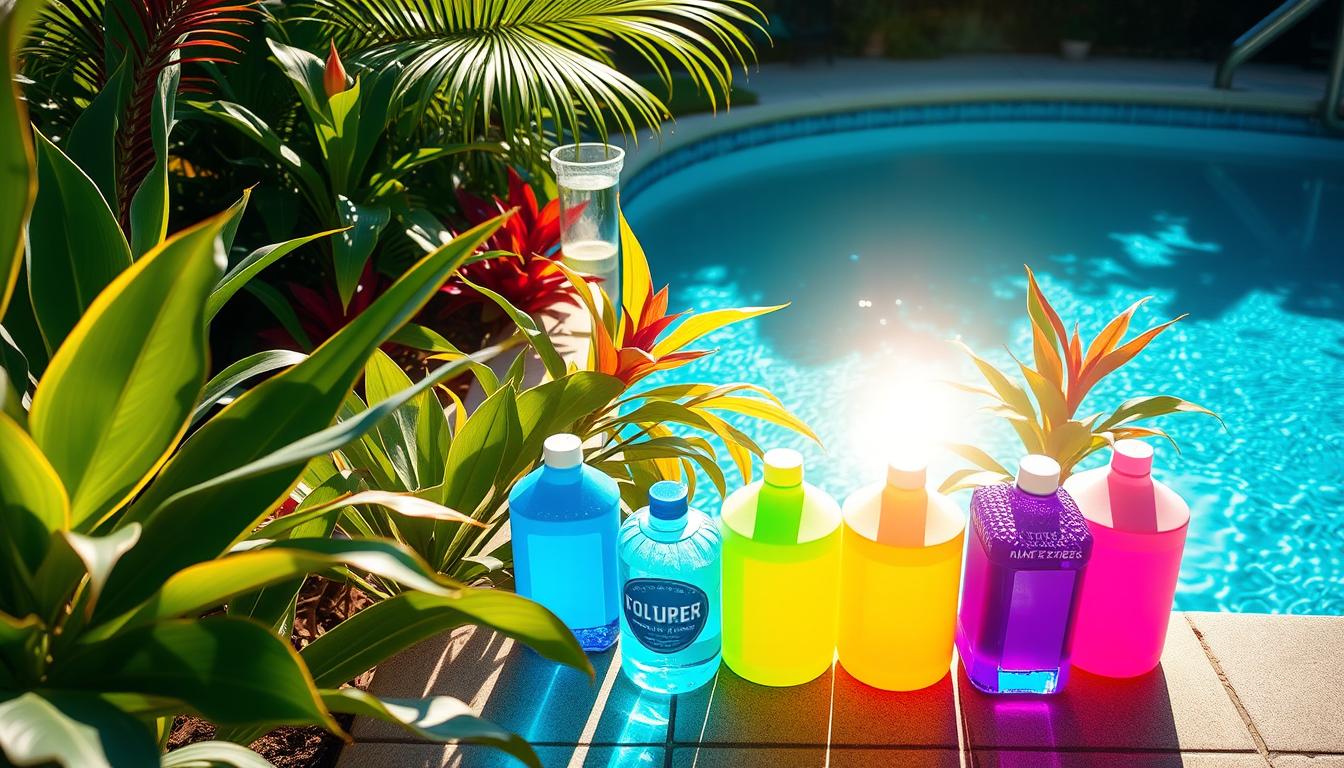
Proper pH balance in your pool is key for safe swimming. Adding acid is one way to adjust pH levels. Let’s explore how long you should wait before diving in after treatment.
We’ll look at pool acid types, pH importance, and recommended waiting times. Safety is crucial when using these chemicals.
Pool chemicals keep water clean and safe. Use them correctly and wait the right amount of time after applying. Unbalanced pH can irritate eyes and skin.
It can also damage pool equipment. Test water regularly with strips or liquid kits. The ideal pH range is 7.2 to 7.8.
This balance prevents eye irritation and corrosion. It also ensures clean, clear water for enjoyable swimming.
Key Takeaways
- Maintaining proper pH balance is essential for a safe and enjoyable swimming experience
- Various types of acid are used to adjust pool pH levels, each with different waiting periods before swimming
- Unbalanced pH levels can cause eye and skin irritation and damage pool equipment
- Regular testing with strips or liquid kits helps maintain a balanced pH within the ideal range of 7.2-7.8
- Following recommended waiting times after adding acid is crucial for pool acid safety
Understanding Pool Acid and pH Balance
Proper pool chemical handling is key for safe swimming. Balancing pH levels and using the right acids are vital for healthy pool water.
These steps ensure a fun and safe swimming experience. They also help maintain the pool’s cleanliness and equipment.
Types of Acid Used in Pools
Several acids are used in pools to maintain ideal pH balance. These acids help ensure effective chlorine and pH levels.
- Muriatic acid
- Sodium bisulfate
- Sulfuric acid
- Acetic acid
- Citric acid
- Phosphoric acid
Each acid type has unique properties, benefits, and precautions. Pool owners should know these when choosing the right one.
Importance of Maintaining Proper pH Levels
Proper pH levels are crucial for swimmer comfort. They prevent eye and skin irritation caused by unbalanced water.
The right pH balance is essential for chlorine effectiveness in pool disinfection. The ideal pH range is between 7.2 and 7.8.
Proper pH levels maintain water clarity and prevent harmful bacteria growth. This ensures healthy conditions for all swimmers.
Maintaining the pH level of pool water between 7.2 and 7.6 is advised for swimmer comfort and chlorine efficacy.
Effects of Unbalanced pH on Swimmers and Pool Equipment
Unbalanced pH levels can harm swimmers and pool equipment. High pH (above 7.8) can cause several issues.
- Eye and skin irritation for swimmers
- Cloudy water
- Reduced chlorine effectiveness
- Scale formation on pool surfaces and equipment
Low pH (below 7.2) can also cause problems. These include:
- Corrosion of pool surfaces and equipment
- Etching of plaster and concrete surfaces
- Swimmer discomfort, such as itchy skin and burning eyes
Regular testing and pH adjustment are essential. Use appropriate acids and follow proper chemical handling guidelines.
This helps maintain healthy pool water and prevents issues. It ensures a safe and enjoyable swimming experience.
| Parameter | Ideal Range | Effects of Imbalance |
|---|---|---|
| pH | 7.2 – 7.8 | Eye and skin irritation, reduced chlorine effectiveness, scale formation, corrosion |
| Alkalinity | 80 – 120 ppm | Difficulty maintaining stable pH, cloudy water, scale formation |
| Chlorine | 1 – 4 ppm | Inadequate disinfection, swimmer discomfort, algae growth |
| Cyanuric Acid | 20 – 50 ppm | Chlorine breakdown due to UV exposure, reduced sanitizer effectiveness |
How Long After Adding Acid to Pool Can You Swim?
Pool owners often wonder about safe swimming after adding acid. The wait time depends on the acid type, amount, and pool size. Let’s explore these factors and provide guidelines for safe swimming after treatment.
Factors Affecting Wait Time After Adding Acid
Several factors influence the waiting period after acid treatment. These include the type and amount of acid used. Pool size and filtration system efficiency also play a role.
- Type of acid used (muriatic acid, sodium bisulfate, etc.)
- Amount of acid added to the pool
- Size of the pool (larger pools may require longer wait times)
- Circulation and filtration system efficiency
Recommended Wait Times for Different Types of Acid
Here are general guidelines for waiting periods after adding various acids to your pool:
| Type of Acid | Recommended Wait Time |
|---|---|
| Muriatic Acid | 30 minutes to 1 hour |
| Sodium Bisulfate | 30 minutes to 1 hour |
| Dry Acid | 15 to 30 minutes |
It’s essential to always follow the manufacturer’s instructions for the specific product you are using and to ensure proper circulation during the waiting period.
Testing Pool Water Before Swimming
It’s crucial to test the water before swimming after adding acid. The ideal pH range for pools is between 7.2 and 7.8. Use test strips or a liquid kit to check pH levels.
- Test the pool water at least 30 minutes after adding acid
- Ensure the pH level is between 7.2 and 7.8
- If the pH is still too low, wait an additional 30 minutes and test again
Follow these tips for a safe and enjoyable pool experience. Regular testing and proper pH maintenance are key to a healthy swimming environment. Remember to check chlorine levels too for optimal pool health.
Conclusion
Healthy pool water is crucial for swimmer safety and enjoyment. Proper acid use balances pH levels, creating a safe swimming environment. Follow recommended wait times after adding acid for optimal results.
Regular water testing maintains chemical balance. Monitor pH (7.2-7.6) and alkalinity (80-120 ppm) closely. Handle pool chemicals safely and wear protective gear.
Prioritizing pool safety extends equipment life and maintains cleanliness. A proactive approach to maintenance ensures a great swimming experience all season long.







